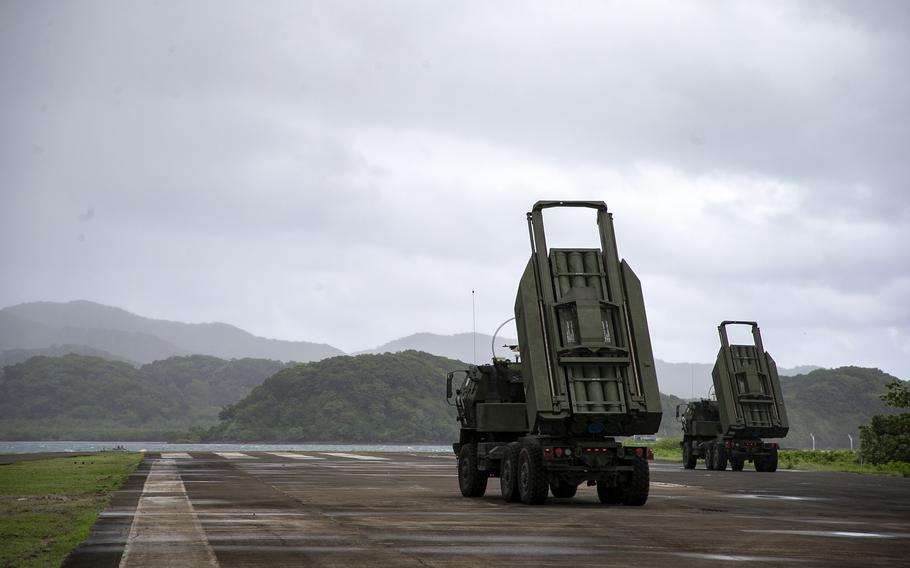
U.S. Marines deploy High Mobility Artillery Rocket Systems during Balikatan 22 in northern Luzon, Philippines, April 4, 2022. In Balikatan 24, which begins next week, the Philippines and the U.S. will for the first time conduct joint naval drills beyond the 12 nautical miles of the Philippines’ territorial waters, in parts of open sea claimed by China. More than 16,000 soldiers from the two militaries will operate out of a joint command center to perform four major activities with a focus on countering maritime and air attacks. (Melanye Martinez/U.S. Marine Corps)
MANILA — The Philippines and the United States are preparing to hold their most ambitious joint military exercise yet next week as tensions between the Philippines and China escalate in the South China Sea, according to more than a dozen officials.
For the first time since the annual exercise started in 1991, the Philippines and the United States will conduct joint naval drills beyond the 12 nautical miles of the Philippines’ territorial waters, in parts of open sea claimed by China, officials said. More than 16,000 soldiers from the two militaries will operate out of a joint command center to perform four major activities with a focus on countering maritime and air attacks.
Officials said in interviews that in one operation, troops will simultaneously secure two islands along the western and northern coasts of the Philippines before transporting High Mobility Artillery Rocket System, or HIMARS, onto the islands for live-firing exercises. In another operation, Philippine naval vessels will debut a newly procured ship-based missile system, working with U.S. Air Force squadrons to strike and sink a decommissioned ship, said officials.
Throughout the three-week exercise, which is called Balikatan or “shoulder to shoulder” in the Filipino language, battalions from the two countries will focus more than ever before on operating as a single fighting force. Other allies, such as France and Australia, will also participate in certain segments.
“The goal is to make our forces plug and play,” said U.S. Marine Col. Doug Krugman, who led planning for the Marine Corps’ participation.
Commodore Roy Vincent Trinidad, a spokesman for the Philippine Navy, said the message that the Philippines wants to broadcast with is simple: “We are not alone,” said Trinidad. “And we’re ready to defend our sovereign rights.”
Tensions between China and the Philippines are the highest they’ve been in years, raising the specter of war in the Pacific, say security analysts. The situation has become especially perilous around the Second Thomas Shoal, a half-submerged reef where the Philippines has maintained the BRP Sierra Madre, a beached warship, as an outpost since 1999. In recent months, Chinese ships have stepped up efforts to prevent the Philippine Navy from resupplying troops on the Sierra Madre, deploying water cannons that have damaged vessels and injured sailors.
Biden administration officials, including the president, have warned that an armed attack against Philippine military vessels would invoke the U.S.-Philippine mutual defense treaty. Standing next to Philippine President Ferdinand Marcos Jr. in Washington last week, President Biden said the U.S. defense commitment to the Philippines is “ironclad.”
The U.S. military last year secured access to four new staging sites in the Philippines, three of which will be part of this year’s Balikatan exercises, officials said. In one operation, troops will deploy out of Lal-lo airport in the province of Cagayan to secure one of the Philippines’ northernmost islands facing Taiwan. In another, soldiers will use a newly designated air base on Balabac island to enact the defense of Palawan province, located opposite the Spratly Islands, which China has sought to dominate. The drills will simulate the armed recapture of island territories, said Col. Michael Logico, a spokesman for the Philippine military for Balikatan. “If someone takes it, we take it back,” he said.
For the U.S. forces, which have been retooling to prepare for a maritime war against China in the Indo-Pacific, “the access is phenomenal,” said a U.S. military official, who spoke on the condition of anonymity to share previously unreported details of the exercise. For the Philippines, the joint drills provide an opportunity not just to train but to assert its claims in the South China Sea where China has built artificial islands, walled off resource-rich shoals and harassed Philippine vessels, said Philippine defense officials.
The Philippine military was preoccupied in recent decades with domestic insurgencies. Faced now with pressing external threats, it is building up its maritime fighting capabilities, including its ability to attack targets “over-the-horizon,” said officials. During the Balikatan exercise, the military will deploy for the first time a South Korean manufactured ship-based missile system, called C-star, capable of reaching targets 90 miles away.
When the United States and the Philippines announced its expanded defense cooperation last year, officials in Manila stressed that the push to bolster security was “not aimed at any particular country.” Since then, however, rising Chinese assertiveness has prompted Philippine officials to be more explicit. Last month, following tense encounters with China at sea, Marcos said his government was working on “countermeasures” and left no room for question about who they would be aimed at.
Filipinos, the president said, would not yield to “the open, unabating, and illegal, coercive, aggressive, and dangerous attacks by agents of the China Coast Guard and the Chinese Maritime Militia.”